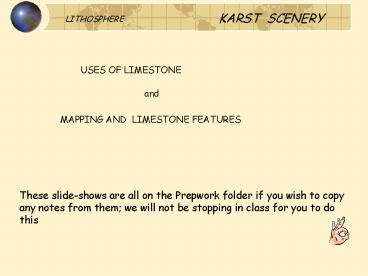USES OF LIMESTONE - PowerPoint PPT Presentation
1 / 20
Title:
USES OF LIMESTONE
Description:
It is possible that you could get a Carboniferous Limestone OS mapping question. ... Carboniferous Period. 300 million years ago. marine plants and animals ... – PowerPoint PPT presentation
Number of Views:95
Avg rating:3.0/5.0
Title: USES OF LIMESTONE
1
USES OF LIMESTONE
and
MAPPING AND LIMESTONE FEATURES
These slide-shows are all on the Prepwork folder
if you wish to copy any notes from them we will
not be stopping in class for you to do this
2
AGRICULTURE IN A LIMESTONE AREA
Note the dry, barren landscape of limestone
plateau, with lusher pastures in the valley below
the limestone.
3
OTHER USES OF LIMESTONE.
Building material
4
As it is very resistant to physical erosion,
limestone is used as a base for road surfaces,
under the tarmacadam.
5
Strip mining limestone in East Lothian - to make
cement.
6
Cement works at Castleton - a blot on the land-
scape or a source of valuable jobs?
7
You will be looking at more issues surrounding
limestone extraction when we study the Rural Land
Resources Case Study areas.
8
You will now be learning how to draw a
cross-section diagram through a limestone area.
This is one of the skills you need to be able to
do to pass the GMT part of this course.
11
There is a sheet to help you through this
exercise.
9
12
Now take a copy of the mapping question-sheet
available in class. Using the Ingleton extract
provided, work your way through the questions,
making sure that you write down careful notes on
each.
10
MAPS and LIMESTONE FEATURES It is possible that
you could get a Carboniferous Limestone OS
mapping question. You would be asked to look at
the map and recognise the evidence of limestone
features, and provide a broad description of the
features and -if asked- offer an explanation as
to how they were formed. Use grid (preferably 6-
figure) grid references and only refer to places
that are named or obvious on the map. (Usually
you can see pot/swallow holes, shake holes,
scars, pavements, reappearing streams/ springs,
gorges, and caverns/ cave systems.)
11
Limestone SceneryMap Recognition and Analysis.
Look at the features on the next two slides. They
show karst features on an O.S map. Make sure that
you can recognise them and know how they were
formed!
12
(No Transcript)
13
(No Transcript)
14
Another GMT technique that you will maybe be
asked to demobstrate is that of aerial
photography interpretation.
gryke
You may be shown a photograph and asked to
annotate it. Labels should be written around the
edge and lines drawn to the feature.
Photographs are used in the same way.
clint
15
Attempt the questions in the Core textbook, page
131. Answer in full in your jotters. Q1a,b Q2a Q3b
13
Carboniferous Questions!
16
Key terms to remember 1
- Carboniferous Period
- 300 million years ago
- marine plants and animals
- Carbonic acid
- Carbonation / chemical weathering
- joints and bedding planes
- dissolving
- Glacio Karst
17
As you go through the next revision slide, for
each feature mentioned, look back through your
textbooks and this presentation. You are looking
for named examples of as many features as
possible.
Perhaps you could work in pairs to do this task!
18
Key terms to remember2
- gorges, scars, dry valleys
- watersinks, resurgents
- caves and caverns
- Calcite
- flowstones / dripstones
- stalactites / stalagmites / pillars
19
Exam questions
- OR
- in Paper 2 - Rural Land Resources.
- REMEMBER - Limestone scenery may be tested in
Paper 1 - Lithosphere
There is a homework exercise to do.
20
Exam questions
- REMEMBER - Limestone scenery may be tested in
Paper 1 - Lithosphere - OR
- in Paper 2 - Rural Land Resources.
There is a homework exercise here.
END































